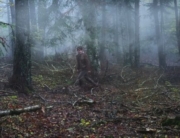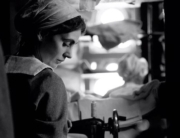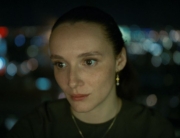In 1961, Francisco de Goya’s portrait of the Duke of Wellington, which the British government had recently acquired for 140,000 pounds, vanished 19 days after it had been put on display to great fanfare. It was the first–and last–painting to be stolen from London’s National Gallery. Was the thief “a well-trained commando” working for a highly organized criminal organization, as the befuddled authorities in the late Roger Michell’s crowd-pleasing if predictable penultimate film The Duke suspect?
In the opening scene, 60-something Kempton Bunton (played with brio by Jim Broadbent) is on trial for the crime and pleads not guilty. “I borrowed it for the greater good.” The film then flashes back six months earlier to gritty Newcastle, in northeast England, where the chronically unemployed, eccentric autodidact is mailing his latest play to the BBC and refusing to pay the television license fee that he believes should be free for all pensioners. His exasperated, long-suffering wife, Dorothy (a flinty Helen Mirren), promises to pay the fee, but Kempton opts for jail time as a matter of principle. The bread winner for the entire family, Dorothy works as a house cleaner for the middle-class but sympathetic Mrs. Gowling (Anna Maxwell Martin).
While watching the telly, Kempton also rails at the coverage of the purchase of the Goya portrait, complaining that public money has been wasted on the painting of a man who opposed universal suffrage. After he has been fired as a taxi driver because of customer complaints about his incessant talking, he assures Dorothy that he will settle down to a steady job after he travels to London to deliver his free-TV petition to Parliament.
However, Kempton returns home with the Goya; “It’s not very good, is it?” he asks his son Jackie (Fionn Whitehead), who helps him hide the painting behind a false wall in a wardrobe. Ransom notes demanding charitable contributions are sent to the authorities, but Pammy (Charlotte Spencer), the girlfriend of Kempton’s other son, accidentally finds the portrait and threatens to tell the police unless the reward money is split, forcing Kempton’s hand.
Michell’s gentle homage to 1960s caper films features split screens and a jazzy score by George Fenton, and seamlessly integrates the actors into vintage footage (kudos to editor Kristina Hetherington). The actual theft is filmed in comic Pink Panther mode, with a shadowy figure climbing up a ladder and through an unlatched bathroom window. There is even a playful nod to the 1962 James Bond film Dr. No, which featured the missing painting in its villain’s lair.
Despite the excellent cast and authentic period details by production designer Kristian Milsted and costume designer Dinah Collin, the film’s manipulations and rousing reconciliations left this viewer cold. For dramatic purposes, screenwriters Richard Bean and Clive Coleman condensed the story’s time line to six months. In reality, the painting went missing for four years. Did it sit in the wardrobe all that time?
While the film moves swiftly, the concluding trial scenes bog down in sticky sentimentality as a charmed courtroom chuckles at Kempton’s statements. When the verdict is read, Mrs. Gowling bursts into a rousing rendition of that classic English hymn, “Jerusalem.” Yes, there will always be an England of eccentrics who march to the beat of their own drum. And yet what The Duke fails to explore is the deep-rooted inequalities and social disconnection that led Kempton Bunton on this quixotic journey.

















Leave A Comment